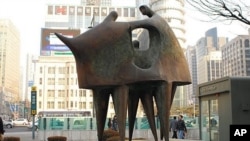This is definitely not art for art’s sake. It is, rather, art for the law’s sake.
A South Korean law requires owners of large buildings to set aside one percent of construction costs for art.
But what qualifies as art? That is left up to design committees run by local governments.
Hong Kyoung-han, the chief editor of "Public Art" magazine, says the result of the 15-year-old law is disappointing.
"More than 90 percent of it is problematic. It has no relationship to the architecture and no form," he said. "There is no artistic sense whatsoever. There are thousands of works of arts on display publicly in Seoul, yet most of them are viewed negatively."
Many critics say they hesitate to regard as art the similar chunks of metal, human-shaped sculptures and reflective orbs plopped in front of most big buildings. So ubiquitous, they generate little notice from passersby.
A few are harder to ignore. A steel company paid nearly $1.5 million to famous sculptor Frank Stella to build "Amabel." Some people have called for its removal, complaining that it quickly rusted.
Oh Se-hoon is the mayor of Seoul. He is a big booster of urban design and the city beautification campaign begun under his predecessor.
Mayor Oh says the one percent law initially deserved praise because it helped beautify cities. But, he says, the law is not achieving its aim.
"Because it is enforced by law, people install art out of obligation without any passion or an eye for true art," he said. "Thus we end up with art that hardly can gain public acceptance."
Magazine editor Hong, however, does not want to see government involvement disappear entirely.
"If we just leave it to the developers of buildings, we cannot expect to see much in the way of cutting-edge, high-level art," he said. "And only a small number of building owners would put art on public display. So, for now, government participation is necessary."
Oh presides over a city that, thanks to the law, has put on display 6,000 sculptures, 1,200 paintings, dozens of murals and hundreds of other items ranging from calligraphy to handicrafts.
"Great art in the right place gives citizens a sense of relief and relaxation," he said. "These days I’m into fun designs which will give people a smile or make them laugh among the hustle and bustle of city life. I want to see art installed here that gives people peace of mind."
To appease those who do not find peace of mind from the more questionable pieces of art, South Korea’s Culture Ministry wants a change of scene. It is proposing an art reform bill. Instead of placing art on their properties, owners could contribute a smaller amount of money to a public art fund.
More of Seoul's public art:
All photos by S. Herman







